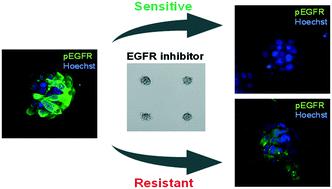Our official English website, www.x-mol.net, welcomes your feedback! (Note: you will need to create a separate account there.)
Non-small cell lung carcinoma spheroid models in agarose microwells for drug response studies
Lab on a Chip ( IF 6.1 ) Pub Date : 2022-05-13 , DOI: 10.1039/d2lc00244b Qiyue Luan 1 , Jeffrey H Becker 2, 3 , Celine Macaraniag 1 , Malek G Massad 2 , Jian Zhou 1, 3 , Takeshi Shimamura 2, 3 , Ian Papautsky 1, 3
Lab on a Chip ( IF 6.1 ) Pub Date : 2022-05-13 , DOI: 10.1039/d2lc00244b Qiyue Luan 1 , Jeffrey H Becker 2, 3 , Celine Macaraniag 1 , Malek G Massad 2 , Jian Zhou 1, 3 , Takeshi Shimamura 2, 3 , Ian Papautsky 1, 3
Affiliation

|
There is a growing interest in developing personalized treatment strategies for each cancer patient, especially those with non-small cell lung carcinoma (NSCLC) which annually accounts for the majority of cancer related deaths in the US. Yet identifying the optimal NSCLC treatment strategy for each cancer patient is critical due to a multitude of mutations, some of which develop following initial therapy and can result in drug resistance. A key difficulty in developing personalized therapies in NSCLC is the lack of clinically relevant assay systems that are suitable to evaluate drug sensitivity using a minuscule amount of patient-derived material available following biopsies. Herein we leverage 3D printing to demonstrate a platform based on miniature microwells in agarose to culture cancer cell spheroids. The agarose wells were shaped by 3D printing molds with 1000 microwells with a U-shaped bottom. Three NSCLC cell lines (HCC4006, H1975 and A549) were used to demonstrate size uniformity, spheroid viability, biomarker expressions and drug response in 3D agarose microwells. Results show that our approach yielded spheroids of uniform size (coefficient of variation <22%) and high viability (>83% after 1 week-culture). Studies using epidermal growth factor receptor (EGFR) tyrosine kinase inhibitor (TKIs) drugs gefitinib and osimertinib showed clinically relevant responses. Based on the physical features, cell phenotypes, and responses to therapy of our spheroid models, we conclude that our platform is suitable for in vitro culture and drug evaluation, especially in cases when tumor sample is limited.
中文翻译:

用于药物反应研究的琼脂糖微孔非小细胞肺癌球体模型
人们越来越有兴趣为每位癌症患者制定个性化治疗策略,尤其是那些患有非小细胞肺癌(NSCLC)的患者,每年美国癌症相关死亡中的大部分都是非小细胞肺癌(NSCLC)患者。然而,由于存在多种突变,为每位癌症患者确定最佳的 NSCLC 治疗策略至关重要,其中一些突变是在初始治疗后发生的,并可能导致耐药性。开发非小细胞肺癌个性化疗法的一个关键困难是缺乏适合使用活检后的极少量患者来源材料来评估药物敏感性的临床相关测定系统。在此,我们利用 3D 打印来演示基于琼脂糖中微型微孔的平台来培养癌细胞球体。琼脂糖孔由 3D 打印模具成型,有 1000 个微孔,底部呈 U 形。使用三种 NSCLC 细胞系(HCC4006、H1975 和 A549)在 3D 琼脂糖微孔中展示大小均匀性、球体活力、生物标志物表达和药物反应。结果表明,我们的方法产生了大小均匀(变异系数 <22%)和高活力(培养 1 周后>83%)的球体。使用表皮生长因子受体 (EGFR) 酪氨酸激酶抑制剂 (TKI) 药物吉非替尼和奥希替尼的研究显示出临床相关反应。根据我们的球体模型的物理特征、细胞表型和对治疗的反应,我们得出结论,我们的平台适合 H1975 和 A549) 用于演示 3D 琼脂糖微孔中的尺寸均匀性、球体活力、生物标志物表达和药物反应。结果表明,我们的方法产生了大小均匀(变异系数 <22%)和高活力(培养 1 周后>83%)的球体。使用表皮生长因子受体 (EGFR) 酪氨酸激酶抑制剂 (TKI) 药物吉非替尼和奥希替尼的研究显示出临床相关反应。根据我们的球体模型的物理特征、细胞表型和对治疗的反应,我们得出结论,我们的平台适合 H1975 和 A549) 用于演示 3D 琼脂糖微孔中的尺寸均匀性、球体活力、生物标志物表达和药物反应。结果表明,我们的方法产生了大小均匀(变异系数 <22%)和高活力(培养 1 周后>83%)的球体。使用表皮生长因子受体 (EGFR) 酪氨酸激酶抑制剂 (TKI) 药物吉非替尼和奥希替尼的研究显示出临床相关反应。根据我们的球体模型的物理特征、细胞表型和对治疗的反应,我们得出结论,我们的平台适合 使用表皮生长因子受体 (EGFR) 酪氨酸激酶抑制剂 (TKI) 药物吉非替尼和奥希替尼的研究显示出临床相关反应。根据我们的球体模型的物理特征、细胞表型和对治疗的反应,我们得出结论,我们的平台适合 使用表皮生长因子受体 (EGFR) 酪氨酸激酶抑制剂 (TKI) 药物吉非替尼和奥希替尼的研究显示出临床相关反应。根据我们的球体模型的物理特征、细胞表型和对治疗的反应,我们得出结论,我们的平台适合体外培养和药物评价,特别是在肿瘤样本有限的情况下。
更新日期:2022-05-13
中文翻译:

用于药物反应研究的琼脂糖微孔非小细胞肺癌球体模型
人们越来越有兴趣为每位癌症患者制定个性化治疗策略,尤其是那些患有非小细胞肺癌(NSCLC)的患者,每年美国癌症相关死亡中的大部分都是非小细胞肺癌(NSCLC)患者。然而,由于存在多种突变,为每位癌症患者确定最佳的 NSCLC 治疗策略至关重要,其中一些突变是在初始治疗后发生的,并可能导致耐药性。开发非小细胞肺癌个性化疗法的一个关键困难是缺乏适合使用活检后的极少量患者来源材料来评估药物敏感性的临床相关测定系统。在此,我们利用 3D 打印来演示基于琼脂糖中微型微孔的平台来培养癌细胞球体。琼脂糖孔由 3D 打印模具成型,有 1000 个微孔,底部呈 U 形。使用三种 NSCLC 细胞系(HCC4006、H1975 和 A549)在 3D 琼脂糖微孔中展示大小均匀性、球体活力、生物标志物表达和药物反应。结果表明,我们的方法产生了大小均匀(变异系数 <22%)和高活力(培养 1 周后>83%)的球体。使用表皮生长因子受体 (EGFR) 酪氨酸激酶抑制剂 (TKI) 药物吉非替尼和奥希替尼的研究显示出临床相关反应。根据我们的球体模型的物理特征、细胞表型和对治疗的反应,我们得出结论,我们的平台适合 H1975 和 A549) 用于演示 3D 琼脂糖微孔中的尺寸均匀性、球体活力、生物标志物表达和药物反应。结果表明,我们的方法产生了大小均匀(变异系数 <22%)和高活力(培养 1 周后>83%)的球体。使用表皮生长因子受体 (EGFR) 酪氨酸激酶抑制剂 (TKI) 药物吉非替尼和奥希替尼的研究显示出临床相关反应。根据我们的球体模型的物理特征、细胞表型和对治疗的反应,我们得出结论,我们的平台适合 H1975 和 A549) 用于演示 3D 琼脂糖微孔中的尺寸均匀性、球体活力、生物标志物表达和药物反应。结果表明,我们的方法产生了大小均匀(变异系数 <22%)和高活力(培养 1 周后>83%)的球体。使用表皮生长因子受体 (EGFR) 酪氨酸激酶抑制剂 (TKI) 药物吉非替尼和奥希替尼的研究显示出临床相关反应。根据我们的球体模型的物理特征、细胞表型和对治疗的反应,我们得出结论,我们的平台适合 使用表皮生长因子受体 (EGFR) 酪氨酸激酶抑制剂 (TKI) 药物吉非替尼和奥希替尼的研究显示出临床相关反应。根据我们的球体模型的物理特征、细胞表型和对治疗的反应,我们得出结论,我们的平台适合 使用表皮生长因子受体 (EGFR) 酪氨酸激酶抑制剂 (TKI) 药物吉非替尼和奥希替尼的研究显示出临床相关反应。根据我们的球体模型的物理特征、细胞表型和对治疗的反应,我们得出结论,我们的平台适合体外培养和药物评价,特别是在肿瘤样本有限的情况下。



























 京公网安备 11010802027423号
京公网安备 11010802027423号